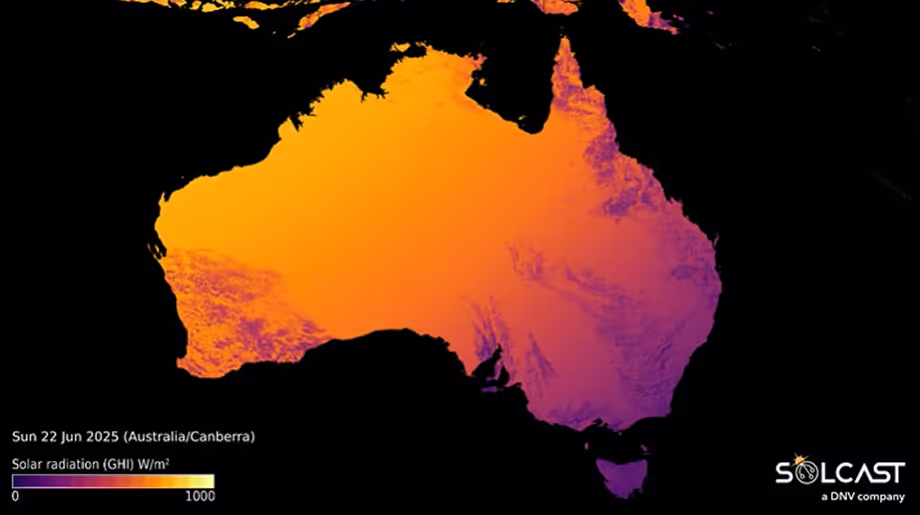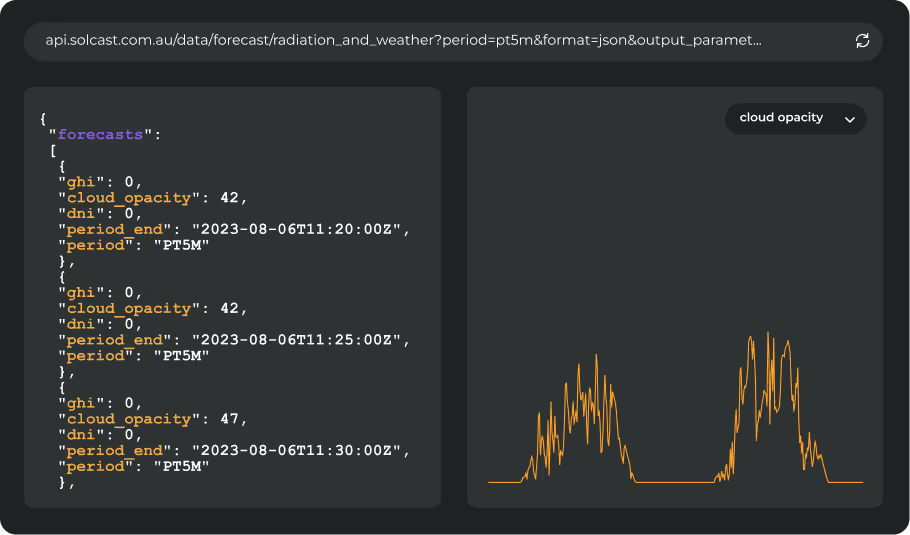Premium
PV Power Forecast Model
We configure and train for you, assuring world’s best accuracy results

This page provides a comprehensive overview of the technical specifications and features of the Premium PV Power Forecast Model, designed for single-site solar energy installations.
Introduction
The Premium PV Power Forecast Model is one of the solar power forecast models available from Solcast, along with the Rooftop PV Power Forecast Model and the Advanced PV Power Forecast Model. The Premium model is best suited to larger solar PV assets (Utility and/or C&I), where accuracy is very important, or where your team doesn't have the expertise or bandwidth to utilise the Advanced PV Power Forecast Model.
Rather than being a single model, the Premium PV Power Forecast utilises a set of models, based on physics and ML, with increased capability for minimising error, increasing forecast features, and enabling customisation to varying forecast requirements prescribed by regulation or by corporate procurement.
Product/Data Specifications
Core features
These features are always included with a subscription to the Premium PV Power Forecast Model.
- Weather Data via API (Starter, Pro or Max): Provides access to granular irradiance and weather data through the Solcast API. Customers choose among the Starter, Pro and Max weather plans, and this determines basic specifications of the Premium PV Power Forecast Model data, such as update frequency and time granularity. The Max plan delivers 5 minute updates of 5 minute granularity data as far as 14 days ahead. You don't need to use the weather data if you don't want to, but you'll have access to it, and we need to use it as one of the inputs to calculating your PV power forecast. It is important to note that in the Premium model, the weather data accessible via API may not always precisely correlate with the specific internal weather models used for the power forecast generation, because we often utilise weather data optimisations to your site, and/or weather data sources not yet available in the Solcast API.
- PV Power Forecast via API (MW): This output parameter delivers power output predictions (in Megawatts).
- PV Power Forecast Percentiles via API (MW) - 10th and 90th Percentiles: These output parameters deliver 10th and 90th percentile forecasts, providing a standard measure of forecast uncertainty. These percentiles indicate the range within which the actual power output is expected to fall, offering insight into potential deviations from the nominal forecast.
- Initial configuration of physical models, utilising your plant specifications: Encompasses the creation of a physical model of your PV plant, alongside the configuration of machine learning (ML) representations.
- Initial QC and cleaning of power output measurement history (3 to 12 months duration): Solcast performs quality control and cleaning of your historical power output measurement data, typically spanning a period of 3 to 12 months. This foundational data quality is vital for training accurate machine learning models.
- Initial creation of ML optimisations to power forecast based on clean measurements: Development and deployment of initial machine learning algorithms designed to optimise the power forecast. These optimizations are specifically generated using your cleaned historical measurement data to enhance predictive performance.
- Ongoing right to request updated optimisation to power forecast (up to 2x per year): Provides the flexibility to request updates or refinements to the machine learning optimizations applied to your power forecast, with up to two such requests permitted per year. This ensures the forecast continually adapts to evolving plant characteristics or environmental conditions.
Premium PV Power: Additional Options
These options can be quoted as additional enhancements when required. The items marked with an asterix usually require more information or scoping prior to us being able to provide a price.
Additional Forecast Uncertainty Percentiles
- Beyond the included 10th and 90th percentiles, we can offer any forecast percentiles from 1% to 99%
Application of schedule of availability and constraint/curtailment to power forecast
The forecasting model incorporates predefined schedules of plant availability and any operational constraints or curtailments. This ensures that the power forecast accurately reflects periods when the plant may not be operating at full capacity due to maintenance, grid limitations, or other factors.
- Use of apply availability or constraint API endpoint (HTTP POST the availability or constraint prior to making forecast request)
- Use of web portal to manually submit your own schedule
Error and accuracy analysis of power forecast
Accuracy analysis and reporting is important in many cases, and also challenging due to data QC issues with operational PV power output data from sites with plant outages, SCADA outages, and other data quality issues.
- Access to forecast accuracy API (HTTP POST timeseries of measured actuals to enable)
- Web portal accuracy views (HTTP POST timeseries of measured actuals to enable)
- Custom web portal accuracy analysis dashboard to your requirements *
- QC and cleaning of your measurements prior to accuracy analysis *
Alternative power forecast data access methods beyond Solcast API access
While standard Solcast API access is provided, additional methods for data retrieval are included to accommodate diverse IT infrastructures and operational workflows.
- FTP, SFTP, Push to API, Push to Cloud bucket using our standard existing methods
- Customisation of power forecast file formats to your requirements *
- Ongoing management or maintenance of data access method required by you *
Visualisation of forecast data
Visualisation of power forecasts is not a common requirement, but we offer it as an option when needed.
- Web portal visualisation of your power forecast data using our standard existing methods
- Custom web portal visualisation dashboard to your requirements *
Use of real time measured power and/or meteorological data in power forecast
In most cases we do not recommend this option, because we already track the real clouds approaching your site using satellite data, and this approach has more predictive power than simply the recent measurements. Also, data quality issues with real time plant measurements can adversely affect the forecast. However, using your measurements can be helpful in some specific cases: (i) when the forecast for the first 1 to 10 minutes ahead is of primary importance, (ii) in polar or oceanic regions where the satellite data coverage is poor or absent, (iii) when cloud patterns over your site are highly abnormal or unpredictable.
- Use of realtime measured plant-total power and/or windspeed and/or irradiance data in power forecast (HTTP POST timeseries of latest measured actuals)
- Implementation and maintenance of automated QC and cleaning of your realtime measured data *
Try the Solcast API
Solcast takes on the many challenges of producing live and forecast solar data, so that you don’t have to. That means making the data easy to access, validate and integrate. We provide instant access to live and forecast data products via this web interface, which is free to try. These include direct estimates of global, direct and diffuse solar radiation, as well as PV power output.









.avif)


